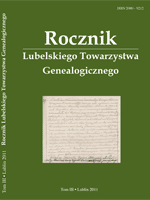Umowa dożywocia jako przykład regulacji majątkowej małżonków w dawnej Polsce
Life contract as an example of financial regulations between spouses in the distant past in Poland
Author(s): Urszula Kicińska Subject(s): Law, Constitution, Jurisprudence
Published by: Lubelskie Towarzystwo Genealogiczne
Keywords: History of Poland 18th century; life annuity contract; marriage contract; Sanguszko Hieronim; Sanguszko Anna; Luboński Stefan; Lubońska Anna;
Summary/Abstract: In the distant past in Poland getting married was accompanied by signing a great deal of necessary documents. These were: marriage contracts, reformatios, waiving by the bride the right to the bride’s parents’ properties (abrenuntiatio), and confirmation of the paid dowry. Among these documents one could also find life contracts, which meant that after the death of his/her spouse, the living spouse can use his/her property until his/her own death. This property could not be sold, exchange or rent unless it was a real property. This life contract became invalid after the user’s death or when a widow/widower decided to marry again. The contract concerned was signed the day or a few weeks after the wedding ceremony. It was a financial protection, especially for women, because it gave, especially widows, financial stability and independence. Such a contract was signed on March 6 1784 by Hieronim Lubartowicz Sanguszko and Anna, née Pruszyńska. Thanks to this document, Anna got from her husband, among others, the town of Sławuta with the nearby villages, livestock form this region, a palace in Sanguszki, and 40 thousand zloty. All this was supposed to be a guarantee for Anna in the case of becoming a widow, and, in accordance with her husband, she could use it until her death. In the distant past in Poland there were childless marriages, too. In such cases the life contract had a different character. A life contract of this character was signed by Stefan Luboński from Luboń, Bracławice cup-bearer of the Crown (died ca. 1739) and Katarzyna, née Gizowska. It was signed in Chęciny on December 30 in 1738.
Journal: Rocznik Lubelskiego Towarzystwa Genealogicznego
- Issue Year: 2013
- Issue No: 5
- Page Range: 266-283
- Page Count: 17
- Language: Polish

